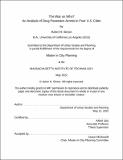| dc.description.abstract | For over half a century, the “War on Drugs” has entailed strict control and policing of illicit drug use in American cities. Despite this policy of criminalization and punishment, large numbers of Americans from all backgrounds continue to use illegal substances, despite the risk of arrest or incarceration. However, the burden of enforcement is not borne evenly across different demographic groups. In particular, black men appear to suffer from disproportionate levels of arrest for drug possession.
This thesis seeks to contribute to the existing understanding of inequities in drug possession arrests, especially as related to race, while explicitly addressing the role of the distribution of illicit drug use across different groups in determining patterns of arrests for possession. By combining drug possession arrest data from four U.S. cities (Los Angeles, Chicago, New York City, and Dallas) with national survey data estimating illicit drug use and population data, I create a series of multiple linear regression models that estimate the relationship between the propensity of arrest for drug possession and age, sex, racial background, and estimated illicit drug use. I find that, even after controlling for the estimated distribution of illegal drug use, along with demographic factors, significant disparities continue to exist in all four cities studied – specifically, black men are most likely to be arrested. These results provide further evidence that differences in use by identity cannot explain relative levels of arrest, lending support to theories that attribute these disparities to either police bias or differences in social or neighborhood context. I also find evidence suggesting that specific policy changes in two cities – Proposition 47 and 64 in Los Angeles and the end of Stop-and-Frisk in New York City – appear to have significantly reduced the magnitude of disparities in drug possession arrests. This further evidences the salience of enforcement strategy in driving disparate outcomes and implies that further changes in illicit drug enforcement policy have the potential to ameliorate existing inequities. | |
